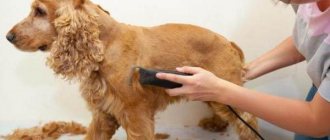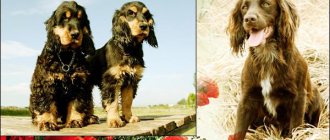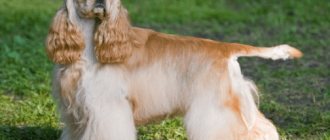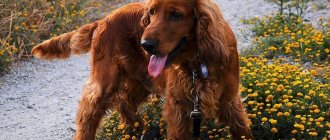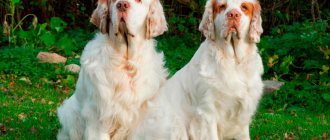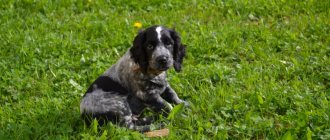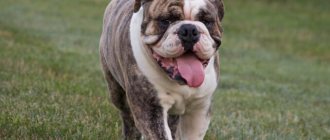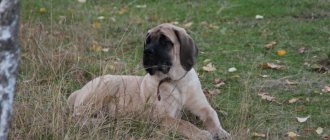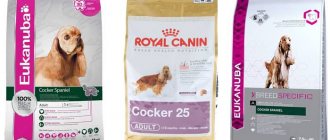February 2847915dog breeds spaniel
The English Cocker Spaniel is a wonderful breed of dog that is perfect as a pet and will bring a lot of joy to its owner. The English Cocker Spaniel breed is a hunting breed and was previously used only for bird hunting. Today the English Cocker Spaniel dog is a popular pet; it is very good-natured and active. In this article you will find a lot of interesting and useful information about the English Cocker Spaniel dog.
Characteristics and breed standard
The English Cocker Spaniel is a small dog with well-developed muscles. The chest is wide, the legs are straight, of medium length, strong.
Height at withers: males 39-41 cm, females 37-39 cm Weight: 12.5-14.5 kg
Color: chocolate, black, gold, red, possible presence of tan marks. A white spot is allowed on the chest. There are two-color (black and white, lemon and white, chocolate and white, red and white with or without markings) or tri-color (black and white or chocolate and white with tan) spaniels. The common color is roan (roan-blue, chocolate-roan, roan-red, possible presence of tan marks).
- The dog's body is covered with soft, smooth, silky hair. On the hind legs the hair forms “pants”, on the muzzle and paws it is short. The length of the ears is continued by the long, straight coat.
- The nose is black, chocolate color is allowed if the coat color is chocolate or white-chocolate.
- The ears are long, hanging, low-set - the “calling card” of the spaniel.
- The tail is docked or naturally shaped and carried below the level of the back when the dog moves.
- The eyes are expressive, large, with a smart and at the same time playful expression.
- Eye color varies depending on coat color: brown, dark brown, hazel.
For clarity, we will show the differences in the exterior of the English and American Cocker Spaniel.
History and description of the breed
The homeland of the English Cocker Spaniel is England, although its ancestors were brought from Spain - hence the name “spaniel”. But there are also opponents of this theory, who claim that cockers appeared in England, and Spain has nothing to do with it. The second part of the breed’s name is “cocker”, translated from English as “woodcock”.
Possessing a keen sense of smell, quickly moving through thickets and skillfully spooking game, spaniels have won the attention and love of hunters. They were used in falconry hunting game with a net - the dog crawled close to the bird and lay down, the falcon did not allow the bird to fly, and the hunter covered the cocker and the game with the net. Spaniels are excellent swimmers and can retrieve wounded birds from the water , and therefore are suitable for gun hunting.
Purposeful selection began in the 19th century, by which time two types of spaniels had emerged: springers and cockers. The ancestor of the English cockers is considered to be a dog named Obo . The first exhibition at which the breed was demonstrated took place in 1859. The Fédération Cynologique Internationale recognized the English Cocker Spaniel as a breed in 1974.
It is interesting that in the first years of the breed’s existence, only dogs weighing up to 11 kg were recognized as purebred; over time, the standard changed.
Price
Buying a spaniel is not easy. Advertisements can be found on the Internet, on special boards on city streets, and even on lampposts. But such a purchase is sometimes risky if you want to acquire a purebred “specimen.” The best way out is to contact a nursery.
Then the chosen baby will be healthy and with all the necessary documents. Although, if your goal is not to participate in exhibitions, acquire a hunting companion, or make money from mating, it is quite possible to adopt a puppy from the author of a private ad. But before that, it’s good to look at it and get as much information and all the necessary documents from the seller as possible.
The price of a Russian Cocker Spaniel depends on the place where it is bought. A private owner can sell a puppy for fifty to one hundred dollars. A “premium class” baby from a nursery with a solid reputation will cost about six hundred, but there are also much more expensive ones, far over a thousand. On average, a purebred little friend can cost in the range of three hundred to four hundred dollars.
Character and temperament
The English Cocker is an energizer whose tail wags non-stop. He loves to be the center of attention, is sociable and dependent on people. It is not recommended to leave dogs alone - loneliness is fraught with disturbances in the psycho-emotional state and the appearance of behavioral problems.
Pros:
- good hunter;
- brave and resilient;
- playful;
- smart;
- affectionate and devoted;
- distrustful of strangers.
Minuses:
- overly active;
- easy to spoil;
- prone to loud barking.
English cocker spaniel and man
This is a tireless hunter, a wonderful friend and companion. He is devoted to his owner and is ready to follow him to the ends of the earth. Thanks to its compact size and easy care, an Englishman feels good both in a country house and in a city apartment, provided there are active walks, activities, and communication with the owner. It is not advisable for older people and those who do not like active recreation to have a spaniel.
The spaniel cannot act as a full-fledged guard, but it makes a good “bell” - this breed is prone to loud barking with or without reason, and will warn you of the approach of a suspicious stranger.
This is a tireless friend for children . He is patient with little ones and will not bite a child. The main thing is to ensure that children do not torture the dog. The cocker is “for anything except a hunger strike” and happily joins in outdoor games with children - catching up, fetching the ball, hide and seek.
He is patient with other pets, but can also get into conflict with a cat or other dog.
Maintenance and care
An Englishman does not need a lot of space to live, so he lives comfortably even in a small one-room apartment . The main condition for keeping a dog is constant communication with a person, and therefore it is impossible to keep a spaniel in an enclosure . In addition, living on the street is contraindicated for him: in the cold season he will freeze and catch a cold.
If the cocker does not realize his seething energy, chewed furniture and howling under the door are guaranteed.
walk your dog at least 2 times a day , but it doesn’t hurt to make one walk 2 hours long and include a jog. Use your pet’s sharp mind and hunting instincts in sports competitions, which he will be delighted to attend. Obedience, agility, freestyle - he has no equal here. If you can visit bodies of water during the warm season, you will make your dog happy - the love of swimming among cockers is inherited.
Feeding
The dog is active and needs high-calorie . The diet should contain lean meat (beef, horse meat), boiled offal (heart, lungs, liver), fish taken from the bones (cod). It is useful to add vegetables (carrots, cucumbers), herbs and fruits, except citrus fruits, to the bowl. A cocker will not refuse buckwheat or oatmeal, but still the majority of the portion should be meat. Periodically treat your pet with cottage cheese or kefir.
The portion of a working or sports dog should replenish the energy expended, and therefore it should be increased compared to the portion of a companion dog.
If you feed your pet dry food, do not mix it with natural food - this will harm your pet's health. Food is offered 2 times a day.
Grooming and cutting
The wool requires regular brushing with a soft brush, otherwise it will become tangled and create tangles. Bath the dog as it gets dirty, but at least 3-4 times a year. The hair in the area of the paw pads and between the toes is trimmed. Dogs are also shorn/trimmed before the show. Grooming an animal is a responsible matter, entrust it to a professional.
Ears should be cleaned periodically with a cotton swab to avoid wax buildup and disease.
The eyes are wiped as necessary with a cotton swab soaked in tea solution, and the claws are cut if they do not grind off naturally.
What to feed for the first 3 months?
For at least 2-3 weeks, and preferably 30-40 days, the main food for puppies should be mother's milk.
The exception is when this is impossible for some reason, then the breeder needs to feed the entire litter himself, using unsweetened and lactose-free infant formula or, better yet, special bitch milk substitutes, for example, Royal Canin Babydog Milk.
After the main lactation period, i.e. about a month after the puppies are born, they need to start giving complementary foods in the form of ground vegetables, fermented milk products or soaked dry food.
At 2 months, the puppy should be familiar with most of the foods allowed for spaniels in order to be as prepared as possible for moving to a new home.
New products must be introduced into the menu gradually, observing how the puppies’ bodies react to them and whether there are any negative reactions.
Training and education
English cockers are highly intelligent and a pleasure to train. They are ready to serve the owner, so even a beginner can raise a dog.
It is better to organize training in the form of games using positive reinforcement; harshness is acceptable only in minimal quantities (do not confuse it with cruelty), since these dogs are prone to dominance.
Training a hunting spaniel will be useful not only for hunting, but also for participation in hunting competitions. Full training begins when the puppy is 6-8 months . But there are also exercises that are practiced when the puppy is still small. To begin with, the dog’s ability to catch odors is developed using the upper sense.
Description of the exercise: place a piece of treat at a height of up to 1.5 m and give the dog the “search” .
The training lasts one hunting season. During this time, the dog learns to find and pick up game, and after that, not to chase and lie down, giving the hunter the opportunity to shoot. After the shot, the dog goes for the game carcass and brings it to the owner.
How to choose a puppy?
Before you make a choice, you need to decide on your goals. What is a dog for? Will it be a guard, a hunter, or just a friend?
You also need to evaluate your capabilities and conditions, namely:
- How many people are in the family?
- If there are small children.
- How busy your schedule is and whether you have enough time for your pet.
- Who will walk the dog and will there be enough money to maintain it?
If you have decided on the first part of the question, then you can proceed to the second - choosing a nursery.
A serious kennel always has a positive reputation among real dog breeders. You also need to understand that a “good” puppy will not be cheap. However, there are breeders who take advantage of customers' ignorance and sell puppies at more than their real value.
To prevent this from happening, carefully look at the conditions in the nursery, and also ask to see the babies’ parents and their documents.
Another sign of a good kennel is that the puppy has a veterinary passport, card and brand.
If everything is fine with this, then you can begin examining and selecting the baby.
There are several criteria here:
- Physical and mental health.
- Exterior.
- Compliance with breed standards, including color.
To avoid making mistakes, be sure to familiarize yourself with the breed standards and criteria for choosing puppies before purchasing.
IMPORTANT!
In conclusion, it is worth saying that some spaniels have a bullying character and are quite capable of starting a fight with their fellow tribesmen. Therefore, you should not let them off the leash in public places. At the same time, proper education and training will help reduce this problem to a minimum.
Health and life expectancy
Representatives of the breed live 12-15 years .
English cockers are gentle dogs, although they have strong immunity. They are susceptible to the following diseases:
- eye diseases (cataracts, conjunctivitis, glaucoma, entropion, retinal atrophy);
- otitis;
- urolithiasis disease;
- food allergies;
- hip dysplasia;
- hypothyroidism;
- hepatitis.
Vaccination schedule
| Age | Nobivak vaccine | Eurikan vaccine |
| 7 weeks | Deworming | |
| 8-9 weeks (vaccination against plague, viral hepatitis, adenoviral infections, parvovirus enteritis, parainfluenza, leptospirosis) | DHPPiL | DHPPI2+L |
| 11 weeks | Deworming according to indications | |
| 12 weeks (vaccination against plague, viral hepatitis, adenoviral infections, parvovirus enteritis, parainfluenza, leptospirosis + rabies vaccination) | DHPPiL+R | DHPPI2+RL |
| 1 year | DHPPiL+RL | DHPPI2+RL |
| Vaccinations are then repeated annually at the same time. |
Breed photo
A selection of photos of an English spaniel.
Add a comment Cancel reply

